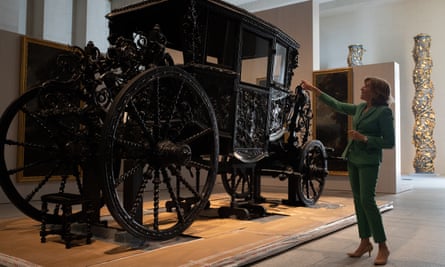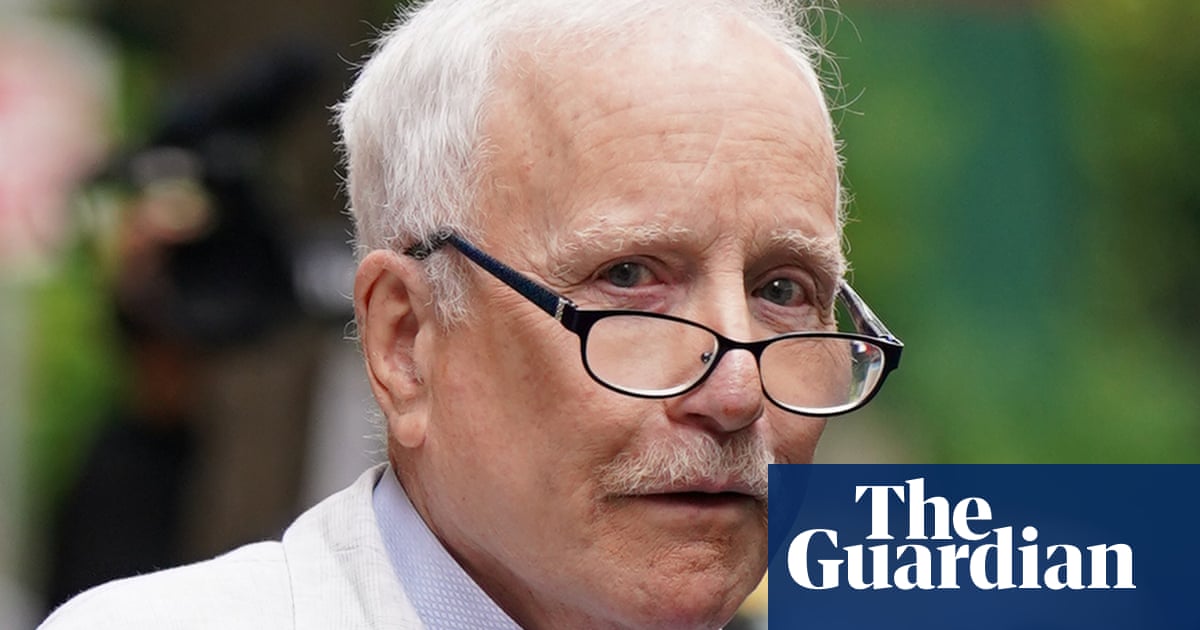A distinctly feminine Archangel Michael brandishes a flaming sword and attempts, as he has for the past 331 years, to trample the living hell out of a forlorn devil.
Close by, an enormous riderless white horse, corralled on to canvas by Diego Velázquez sometime in the 1630s, rears up, as Caravaggio’s Salome, swathed in a blood-red cloak, proffers passersby the freshly severed head of John the Baptist.
On 28 June, these works – along with more than 640 other treasures from Spain’s vast, state-owned royal collections – will go on show as the Spanish capital’s most ambitious museum project in decades finally opens its doors.
Although the idea of creating a gallery to showcase the splendid carriages and tapestries of the royal collections was originally conceived during the Second Republic in the early 1930s, plans for the Museum of Royal Collections were interrupted by the Spanish civil war and the subsequent Franco dictatorship.
Despite a green light from the government in 1998, the €162m (£143m) project was delayed for a quarter of a century by the discovery of a huge chunk of Madrid’s 9th-century Arab wall, then by the 2008 financial crisis and, more recently, by the Covid pandemic.

Overseen by Spain’s national heritage institution, Patrimonio Nacional, the gallery’s aim is to share hundreds of items drawn from the 19 royal palaces and 10 monasteries under Patrimonio Nacional’s stewardship.
Ana de la Cueva, president of Patrimonio Nacional, told the Guardian during a preview tour: “Unlike other museums in Madrid, this is a museum of different collections – it’s not just a museum of painting or sculpture.”
“This museum shows all the luxury goods that our monarchs collected: fans, clocks, glassware, reliquaries, tapestries, rugs, furniture, gilt ware and musical instruments.”
In its different areas – the Habsburg monarchs, the Bourbon dynasty and 20th century Spain – the gallery aims to gather together five centuries of history and to map both the changing country and the changing tastes of its rulers.
De la Cueva said: “You can see the history of Spain in the history of these collections, and I think that really complements the royal palace. Many of these pieces have never been seen and they’re just spectacular when it comes to the artists who made them.”

The martial might of Charles V is reflected in one of his silver and gold suits of armour and in the massive tapestry that shows him inspecting his troops in Barcelona. The devout, austere Catholicism of his son, Philip II, meanwhile, is apparent in the crucifixion by the Italian painter Titan that once hung in the sacristy of Madrid’s epic El Escorial monastery, and in the Adoration of the Holy Name of Jesus, the first work that the Greek artist El Greco painted for the king.
Besides the Caravaggio, whose colours and contrasts appear as fresh as the day they were painted, there are works by the Spanish painter Francisco Goya, reliquaries, bread moulds, pianos, mirrors, sumptuous carriages, and four magnificent, vine-choked Spanish baroque pillars that were rescued from a fire in a 17th-century hospital.
Perhaps the most arresting work, however, is the lovingly restored wooden sculpture of Saint Michael’s Archangel Vanquishing the Devil. The piece was created in 1692 by Spain’s Luisa Roldán – better known as La Roldana – the first woman to become a court sculptor. A team of more than 20 people used a telescopic crane to move the 2.6m-high statue, which weighs 157.5kg (24st 8lb), from a workshop on the fourth floor of the royal palace.
As the restored statue was unveiled last month, Leticia Ruiz, the director of the new museum, said: “Seeing the archangel on his last flight towards the gallery was one of the most exciting transfers I’ve witnessed.” Ruiz said she hoped the statue’s pride of place in the new museum would allow its creator – “a pioneering figure in a time when women received no recognition whatsoever” – a long-overdue moment of glory.
During the restoration, the devil was shorn of the huge horns that were later additions, and his complexion and features returned to their original, less infernal aspect.
As well as its closely observed anatomical details, from the devil’s veiny arms to his slightly manky toenails, the sculpture is imbued with some very personal touches: Roldán is thought to have modelled the archangel’s face on her own and the devil’s on that of her husband.
after newsletter promotion

The piece is one of De la Cueva’s favourites, although she admits that her list changes on an almost weekly basis. She is equally proud of the section of the Arab wall that has been carefully preserved and can now be viewed through a huge window that offers a glimpse of the Madrid of more than a millennium ago.
While she admits that the resolutely modern 40,000 sq metre gallery may have come as “a bit of a surprise to begin with”, De la Cueva believes it bridges the temporal gap elegantly.
“It blends in so well,” she said. “It’s the same granite and the dimensions are perfectly in keeping with the structure of the palace.”
Along with its amazing views towards the west of Madrid, one of the building’s big surprises is just how light it is inside.
“From outside, you have this verticality and all these sober lines, so you don’t expect all that light to be there,” she said. “The inside really defies your expectations from the outside. When I joined Patrimonio Nacional a year and a half ago, the building was empty. My first reaction was, it would be a real shame to put anything inside here because it’s such a wonderful building.”
Having swiftly jettisoned such objections, De la Cueva hopes that the 1.5 million people who visit the royal palace each year will soon be crossing the plaza to enjoy the gallery. In an effort to show as much of the collection as possible, about a third of the 600-plus exhibits will be regularly rotated and there will also be temporary exhibitions.

The project’s success, however, will not be measured solely by visitor numbers and the aspiration is that the new museum will serve as an aperitivo that will whet people’s appetites for striking out beyond the capital to explore Spain’s history and treasures.
De la Cueva said: “The gallery is going to be a showcase for everything we have at Patrimonio Nacional. As well as its architecture, the gallery will give a quick, easy and very attractive overview of Spain’s heritage and the diversity of its collections around the country … It’ll be a little tourist office to make people think about visiting other royal sites.”

 1 year ago
74
1 year ago
74










 English (US)
English (US)